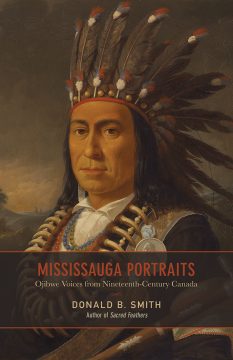Mississauga, like Winnebago or Pontiac, is a vaguely colorful name popularized to describe the bland and conformist without much thought as to what it means or who it represents. Business reporters call this “branding.” In 1967 voters in a Toronto suburb chose “Mississauga” as the name of their city. Few knew then or now who the Mississauga were, or why they vanished.
Mississauga Portraits is a rich, vibrant account of a people who thrived for generations on the north shore of Lake Ontario. Their whole history is erased from the landscape in the same way that revisionists would retouch a painting.
Historian Donald B. Smith recalls that, as a student finalizing his 1975 doctoral thesis, he looked up a 19th century portrait of the Mississauga’s Joseph Sawyer in the art collection of the Toronto Reference Library: “In the oil painting, the head chief of the Mississauga of the Credit appears strong and resolute, neither happy nor sad, without any apparent attitude.”
Years later, Smith makes a disturbing discovery. The chief’s portrait had been retouched to conceal his true expression. “The overpainting mistranslated the painter’s interpretation of his subject’s facial expression. Now, the chief’s look of dejection, deception and betrayal clearly emerged. This is the accurate image.”
The Mississauga hunted, fished and farmed on what is now Dundas Street West in Toronto, when the water was so clean you could angle for salmon. They produced maple syrup and paddled Lake Ontario by birch bark canoe. They also encountered settlers who gave these Ojibwe their mistaken Anglicized name of Mississauga, from ma-se-sau-gee, meaning “clan.”
All this ended by 1820, when the last of the Mississauga’s lands were expropriated for a keg of rum and an ox. “The Mississauga still had no idea of what buying and selling land meant, no idea of the implications of the agreement,” writes Smith, of the University of Calgary.
The epilogue is recounted in vivid detail in Mississauga Portraits. There was Chief Sawyer, who was driven to drink and became such a hopeless alcoholic he sold his own son as a farm labourer for a gallon of whiskey. The boy escaped, and father and son later reconciled.
There was Catherine Sutton, a Christian convert who travelled to London and petitioned Queen Victoria for help. “How can the poor Indian be civilized?” she asked. “As soon as he makes his land valuable then he is driven further back.”
And there was Maungwudaus, another Methodist convert. Out of work and with a family to feed, he organized a “Wild Indian” show and spent the rest of his life on tour. Maungwudaus played the Eastern U.S. where he presented President Zachary Taylor with a pair of snowshoes. He wowed London, where he dined with the Duke of Wellington, and played for royalty in Paris, the whole time jotting meticulous notes of his impressions.
French gentlemen, he said, “never shave their faces; this makes them look as if they have no mouths.” And the English? “The women cannot walk alone; they must always be assisted by their men. They make their husbands carry their babies for them when walking.”
Maungwudaus, like the Mississauga on the Credit River, vanished in the end. The people and their stories are preserved in the pages of Mississauga Portraits.
By Holly Doan
Mississauga Portraits: Ojibwe Voices from Nineteenth-Century Canada by Donald B. Smith; University of Toronto Press; 520 pages; ISBN 9780-8020-94278; $37.95






